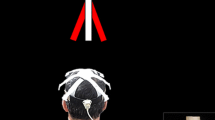Abstract
Purpose
Idiopathic scoliosis (IS) is the most common spinal deformity in adolescents. Defective postural equilibrium may be a contributing factor. The information of the three sensory systems combined enables the formation of a central representation of head position and body posture. Comparison of head angles of girls with and without scoliosis may result in a difference in head orientation.
Methods
25 girls with IS and 16 girls without scoliosis (NS) between the age of 10–16 years stand in a special constructed box on a roll-tilting platform (tilt −14° to +14°).
Results
NS and IS subjects behave quite similarly if there is no sensory conflict, but if there is conflict, the differences between the two groups are greater, especially within the 13- to 14-year-old category.
Conclusions
The differences between groups for different age categories suggest that the process of development of sensory integration for estimation of verticality appears to be different for girls with scoliosis.










Similar content being viewed by others
References
Simoneau M, Mercier P, Blouin J, Allard P, Teasdale N (2006) Altered sensory-weighting mechanisms is observed in adolescents with idiopathic scoliosis. BMC Neurosci 7:68–76
Chockalingam N, Cochrane T, Ahmed E, Dangerfield P, Rahmatalla A (2004) Assessment of ground reaction force during scoliotic gait. Eur Spine J 13(8):750–754
LeBlanc R, Rivard C, Poitras B, Labelle H (1997) Relation between adolescent idiopathic scoliosis and morphologic somatotypes. Spine 22(21):2532–2536
Lopez C, Bachofner C, Mercier M, Blanke O (2009) Gravity and observer’s body orientation influence the visual perception of human body postures. J Vis 9(5):1–14
Barnett-Cowan M, Harris LR (2008) Perceived self-orientation in allocentric and egocentric space: effects of visual and physical tilt on saccadic and tactile measures. Brain Res 1242:231–243
Tarnutzer AA, Bockisch C, Straumann D, Olasagasti I (2009) Gravity dependence of subjective visual vertical variability. J Neurophysiol 102(3):1657–1671
Asch SE, Witkin HA (1948) Studies in Space Orientation II. Perception of the upright with displaced visual fields and with body tilted. J Exp Psychol 38(4):455–477
Brandt T, Dieterich M (1999) The vestibular cortex. Its locations, functions, and disorders. Ann N Y Acad Sci 871:293–312
Cheung J, Sluiter WJ, Veldhuizen AG, Cool JC, van Horn JR (2002) Perception of vertical and horizontal orientation in children with scoliosis. J Orthop Res 20(3):416–420
Sahlstrand T, Ortengren R, Nachemson A (1978) Postural equilibrium in adolescent idiopathic scoliosis. Acta Orthop Scand 49(4):354–365
Herman R, Mixon J, Fisher A, Maulucci R, Stuyck J (1985) Idiopathic scoliosis and the central nervous system: a motor control problem. The Harrington lecture, 1983. Scoliosis Research Society. Spine 10(1):1–14
Simoneau M, Lamothe V, Hutin E, Mercier P, Teasdale N, Blouin J (2009) Evidence for cognitive vestibular integration impairment in idiopathic scoliosis patients. BMC Neurosci 10:102–108
Sahlstrand T, Petruson B (1979) A study of labyrinthine function in patients with adolescent idiopathic scoliosis. Acta Orthop Scand 50(6):759–769
Lambert FM, Malinvaud D, Glaunès J, Bergot C, Straka H, Vidal PP (2009) Vestibular asymmetry as the cause of idiopathic scoliosis, A possible answer from Xenopus. J Neurosci 29(40):12477–12483
Wiener-Vacher SR, Mazda K (1998) Asymmetric otolith vestibular–ocular responses in children with idiopathic scoliosis. J Pediatr 132(3):1028–1032
Wyatt M, Barrack R, Mubarak S, Whitecloud T, Burke S (1986) Vibratory response in idiopathic scoliosis. J Bone Joint Surg Br 68(5):714–718
Barrack RL, Wyatt MP, Whitecloud TS 3rd, Burke SW, Roberts JM, Brinker MR (1988) Vibratory hypersensitivity in idiopathic scoliosis. J Pediatr Orthop 8(4):389–395
McInnes E, Hill DL, Raso VJ, Chetner B, Greenhill BJ, Moreaum MJ (1991) Vibratory response in adolescents who have idiopathic scoliosis. J Bone Joint Surg Am 73(8):1208–1212
Hirabayashi S, Iwasaki Y (1995) Developmental perspective of sensory organization on postural control. Brain Dev 17(2):111–113
Tanahashi S, Ujike H, Kozawa R, Ukai K (2007) Effects of visually simulated roll motion on vection and postural stabilization. J Neuroeng Rehabil 4:39–49
Groberg DH, Dustman RE, Beck EC (1969) The effect of body and head tilt in the perception of vertical: comparison of body and head tilt with left and right handed, male and female subjects. Neuropsychologia 7(1):89–100
Stylianides GA, Beaulieu M, Dalleau G, Rivard CH, Allard P (2012) Iliac crest orientation and geometry in able-bodied and non-treated adolescent idiopathic scoliosis girls with moderate and severe spinal deformity. Eur Spine J 21(4):725–732
Forssberg H, Nashner LM (1982) Ontogenetic development of postural control in man: adaptation to altered support and visual conditions during stance. J Neurosci 2(5):545–552
Riach CL, Hayes KC (1987) Maturation of postural sway in young children. Dev Med Child Neurol 29(5):650–658
Steindl R, Ulmer H, Scholtz A (2004) Standstabilität im Kindes- und Jugendalter. HNO 52(5):423–430
Greffou S, Bertone A, Hanssens JM, Faubert J (2008) Development of visually driven postural reactivity: a fully immersive virtual reality study. J Vis 8(11):15.1–15.10
Conflict of interest
None.
Author information
Authors and Affiliations
Corresponding author
Rights and permissions
About this article
Cite this article
Eijgelaar, P.N., Wapstra, F.H., Otten, E. et al. Altered head orientation patterns in children with idiopathic scoliosis in conditions with sensory conflict. Eur Spine J 23, 2626–2634 (2014). https://doi.org/10.1007/s00586-014-3508-3
Received:
Revised:
Accepted:
Published:
Issue Date:
DOI: https://doi.org/10.1007/s00586-014-3508-3




